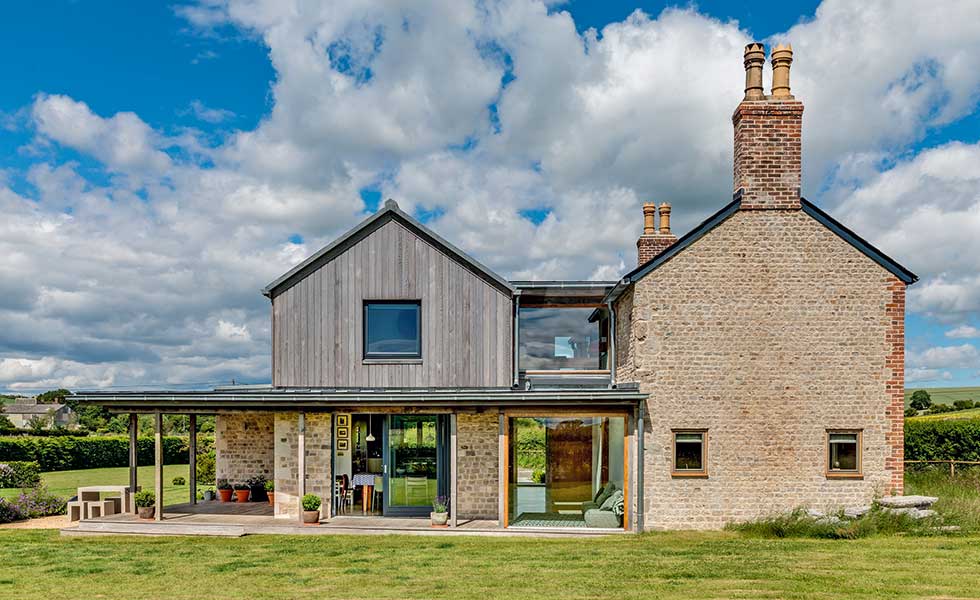

If you're extending for under £100,000, our guide is here to help you make the most of your money while increasing your living space with clever and stylish design. Our industry experts offer advice on everything from planning dilemmas to design limitations, while managing your expectations of what a £100,000 extension budget can offer.
Read our ultimate guide to extending a house for lots more information. Get a definite idea of what your budget can do with our extension cost calculator.
1. Understand what can you expect from a £100,000 extension budget
Marta De Sousa of property developer Lux Reality suggests that with a budget of £100,000 you needn’t restrict yourself to planning a single storey extension. ‘With this budget you can consider building a double storey extension at the back or on the side of your home.'
‘Outside of London, overheads are less expensive for experts, tradespeople and builders, allowing you to use more of your budget on a creative project with potentially more windows or openings,’ Marta adds.
‘In London, there are many more controls, from what can be delivered to the outside of your home, to noise, parking and traffic restrictions. Your project will be more expensive as your builder will have to take more time and effort to work around them.
‘Structural work, excavation and creating the foundations will make up the bulk of your building and material costs. But it’s the point of access that makes a massive difference here. If your property is in London, it is likely to be terraced, which means you won’t necessarily be able to get any structural beams into the back garden area as easily, or place a digger there – all the digging would have to be done by hand and the rubble taken out through your home, which is very expensive.’
Find ideas for single storey rear extensions under £100,000 in our gallery. Need to keep extension costs down? Read these tips for cutting the cost of an extension.
2. Stick to a simple extension design
Simplicity is key. ‘The more complicated the design for your extension, the more expensive it will be,’ says Marta De Sousa. ‘Adding curved walls, various light wells or very large openings will increase the cost substantially. Putting in two windows is cheaper than one of their combined size, but the more glazing or windows you include, the higher your final cost will be.
‘For this budget, I would keep it simple by choosing ready-made windows of standard sizes and asking your architect to incorporate them into the design. You may also have room to include bi-fold doors.’
Find out more about getting your extension design just right with our guide, and don't miss our kitchen extension ideas under £100,000 for extra inspiration.
3. Be upfront about your budget
Be upfront from the beginning about your budget. ‘If you are employing an architect, you should definitely tell them what the total budget is at the outset so that an appropriate design solution can be found,’ says Alan Cronshaw of Acronym Architecture & Design.
‘Always have at least 10 per cent of your budget set aside as a contingency fund. This will help you if you have to pay for any unforeseen difficulties unearthed once you start building, or allow you to make small design changes during the main construction phase. You will also need to deduct fees for having the architectural and structural drawings drawn up, council planning (if planning permission is needed) and building control,’ Alan continues.
‘If your scheme contains a lot of glass, it may be necessary to employ a thermal consultant to prove that the design is energy efficient. If you are in close proximity to other properties, you may also have to employ a party wall surveyor. Then, when you get prices back from builders, you will know if they are within your budget.’
4. Save money by extending under permitted development
As well as addressing the design of your extension, you can maximise your spend in other ways. ‘Explore the possibility of building an extension under permitted development rights,’ says Alan Cronshaw. ‘Rear extensions that meet certain criteria can be added to houses without needing planning permission, even in conservation areas. This may have the added benefit of saving you time as well as money.
‘Consider having the extension finished in painted render rather than facing brickwork, then the construction can be of concrete blocks, which are cheaper and quicker to erect than bricks. Tender the project to four or five builders – you might be surprised at the difference in the prices that you are quoted.’
Check out these homes transformed without planning permission.
5. Consider the budget you're setting aside for interior finishes
The cost of interiors will vary widely depending on the room or rooms that you want to create in your extension.
‘Estimate £5,000 to £10,000 for a bathroom; £7,000 to £10,000 for complete decoration and fully furnishing a living room; and £5,000 to £7,000 for complete decoration and fully furnishing a bedroom. If you're adding a kitchen extension, bear in mind that kitchens are much more expensive to fit out, so estimate £15,000 to £30,000,’ says interior designer Phoebe Oldrey, founder of Smartstyle Interiors.
‘I like to balance the budget by buying anything run of the mill at the best price possible and saving the big bucks for a one-off showpiece that will make the design truly individual.’
6. Consider the build route
'Not many people build their own extensions but you can save £10,000s by taking on the role of project manager, which means organising the labour and the materials yourself, but saving the fee that the main contractor enjoys,' advises self builder and experienced renovator Jason Orme. 'Depending on local conditions and the main contractor's order book, this could be anywhere between 10 to 40 per cent of the overall cost of the project.
'Don't underestimate the amount of time and skill this task needs, in addition, of course, to a healthy contacts book of tradespeople who will genuinely be able to turn up at short notice should the need arise.
'Clearly, the more risk you take on yourself, the more rewards you'll enjoy. The risks you take, of course, are that the rates for trades rise and that materials are more expensive than you had planned – and you probably won't have a clear idea of the final cost until you've finished. With professional project management, on the other hand, you get certainly, fixed costs and an element of reassurance – but you pay for it.'
Find out more about how to project manage an extension or renovation in our guide.
Whatever your budget, find extension advice here:
- House extension ideas from £50,000 to £90,000: see what you could build
- Top 10 tips for designing an extension under £50,000
- House extensions from £30,000 to £50,000: what can you build for your budget?
Join our newsletter
Get small space home decor ideas, celeb inspiration, DIY tips and more, straight to your inbox!
Lucy is Global Editor-in-Chief of Homes & Gardens having worked on numerous interiors and property titles. She was founding Editor of Channel 4’s 4Homes magazine, was Associate Editor at Ideal Home, before becoming Editor-in-Chief of Realhomes.com in 2018 then moving to Homes & Gardens in 2021. She has also written for Huffington Post, AOL, UKTV, MSN, House Beautiful, Good Homes, and many women’s titles. Find her writing about everything from buying and selling property, self build, DIY, design and consumer issues to gardening.
-
 This colourful home makeover has space for kitchen discos
This colourful home makeover has space for kitchen discosWhile the front of Leila and Joe's home features dark and moody chill-out spaces, the rest is light and bright and made for socialising
By Karen Wilson
-
 How to paint a door and refresh your home instantly
How to paint a door and refresh your home instantlyPainting doors is easy with our expert advice. This is how to get professional results on front and internal doors.
By Claire Douglas
-
 DIY transforms 1930s house into dream home
DIY transforms 1930s house into dream homeWith several renovations behind them, Mary and Paul had creative expertise to draw on when it came to transforming their 1930s house
By Alison Jones
-
 12 easy ways to add curb appeal on a budget with DIY
12 easy ways to add curb appeal on a budget with DIYYou can give your home curb appeal at low cost. These are the DIY ways to boost its style
By Lucy Searle
-
 5 invaluable design learnings from a festive Edwardian house renovation
5 invaluable design learnings from a festive Edwardian house renovationIf you're renovating a period property, here are 5 design tips we've picked up from this festive Edwardian renovation
By Ellen Finch
-
 Real home: Glazed side extension creates the perfect garden link
Real home: Glazed side extension creates the perfect garden linkLouise Potter and husband Sean's extension has transformed their Victorian house, now a showcase for their collection of art, vintage finds and Scandinavian pieces
By Laurie Davidson
-
 I tried this genius wallpaper hack, and it was perfect for my commitment issues
I tried this genius wallpaper hack, and it was perfect for my commitment issuesBeware: once you try this wallpaper hack, you'll never look back.
By Brittany Romano
-
 Drew Barrymore's new FLOWER Home paint collection wants to give your walls a makeover
Drew Barrymore's new FLOWER Home paint collection wants to give your walls a makeoverDrew Barrymore FLOWER drops 27 brand-new paint shades, and every can is made from 100% post-consumer recycled plastic.
By Brittany Romano